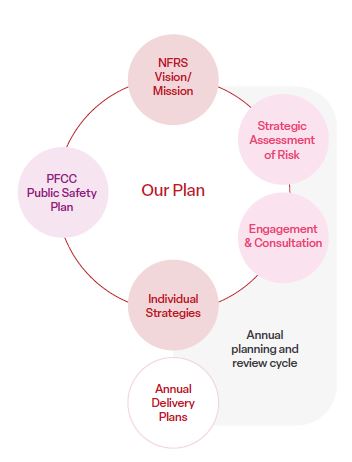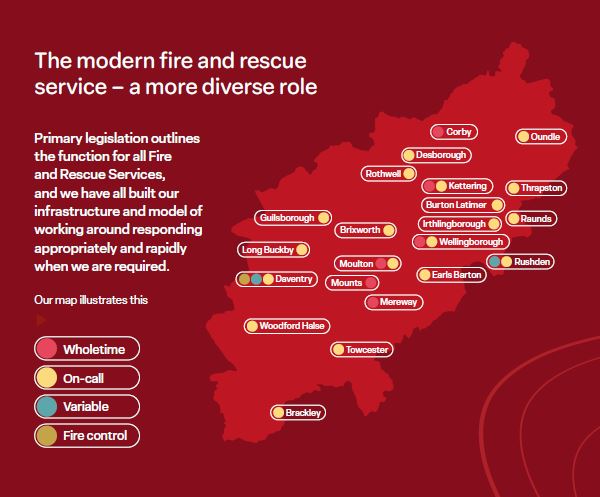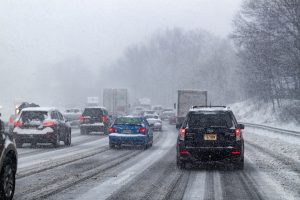Welcome to this draft strategic plan, which sets out the priorities for Northamptonshire Fire and Rescue Service over the next five years.
This plan is based on the risks of fire and other emergencies that face this county and sets out the challenges and opportunities for our fire and rescue service as they focus on keeping us safe.
The role of the fire service continues to evolve. There are now fewer fires, but there are more road traffic collisions, and we have a strong focus on preventing fires and supporting vulnerable people.
Climate change has brought more flooding and wildfire and reminds us of the need to consider our own environmental impact.
This draft strategic plan explains how Northamptonshire Fire and Rescue will use its resources to meet these risks. Much of the work we undertake will be in partnership with other local agencies who share the mission, set out in my public safety plan, to keep Northamptonshire safe and sound.
People in Northamptonshire want to feel safe: they want to know that their fire service will be there when they are needed.
Over the next five years, Northamptonshire Fire and Rescue Service will continue to prevent, protect, and respond to keep communities safe. Our strength is in the commitment of our firefighters and staff, who are resourceful and innovative – and wholly committed to doing their best for this county.
Please let us know what you think of this plan by taking our survey, which is open from 7 April 2025-19 May 2025.

I am pleased to present my first strategic plan as Chief Fire Officer which introduces our areas of focus to achieve our Vision – to provide exceptional fire and rescue services for all and our Mission – to prevent, protect, and respond to keep communities safe.
Within this plan we have set out the current position and our assessment of the risks in Northamptonshire. Our communities must feel safe and confident in accessing the quality service we provide and be assured of the way in which we deliver this.
We have developed the following strategic outcomes within our plan, which are clear, straightforward, and meaningful for our communities, our partners and our workforce.
- Reduce deaths, injuries and damage caused by fire and other hazardous events to our communities.
- Deliver the best value to the public with the least impact on the environment.
- Develop and maintain a diverse, high performing, and healthy workforce.
We want to know what you think of our plan and your help in shaping the future of Northamptonshire Fire and Rescue Service.

As a Fire and Rescue Service, we are required to undertake Community Risk Management Planning – first introduced in 2004 this is now a well-established practice for all fire and rescue services.
To inform this plan, we have undertaken an assessment of the risk in Northamptonshire, we call this our Strategic Assessment of Risk or SAR. Our engagement around this plan with residents, all our staff and key partners will further inform our assessment.
We are operating within a climate of rapid and often unpredictable change – it is therefore key that we continue to learn, strive for improvement and become more agile. We will review our SAR each year with improved data and intelligence to develop Annual Delivery Plans.


We have seen an overall reduction in the number of fires and of casualties and deaths from fire – an indication of the positive impact we have on the communities of Northamptonshire.
Fires now make up less than 30% of all incidents that we attend, which has been reducing over the last five years, as demand from other incidents such as Road Traffic Collisions (RTC) is increasing and our role has expanded.
Response & Preparedness
We are a key partner within the Northamptonshire Local Resilience Forum (LRF) with expectation around our role growing as we learn from national inquiries such as Manchester Arena and Grenfell. Our response to such incidents is just one part of how we mitigate this risk. The role of National Inter-Agency Liaison Officers (NILO) has developed significantly in recent years. NILO’s specialist knowledge assists in the preparation and response to malicious attacks and other incidents which require a multi-agency approach.
Whilst fires and RTCs are more likely to occur than civil emergencies such as flooding and malicious attacks, we must be prepared for the broad range of incidents that we might face. One of the ways in which we prepare is to practice our response capability and regularly arrange multi-agency exercises to run through how we work together. This gives us opportunities to learn and to develop our relationships.
Protection
Changes in legislation such as those around fire safety, combined with the growth of commercial property has increased demand for our Fire Protection Officers in inspecting and auditing business premises. The Protection Team continue to develop information and tools to allow business owners to help themselves, whilst ensuring that those who fail to meet their legal requirements, and place people at risk, are held to account.
Prevention
A combination of changes has seen an increase in the volume and complexity of the cases that our specialist prevention staff handle. We have continued to target our resources towards the high risk individuals in their home for prevention messaging. Good understanding of our different roles and well-developed relationships with partners has seen an increase in referrals, changes in legislation have increased our responsibility around safeguarding, and our duty of care (Serious Violence Duty). Combining some of the data sets we have available to us provides further opportunity to refine and focus how we target Home Fire Safety Visits.
|
|
|||
|
|
|
|
|
|
|
|
|
|
|
|
|
|
|
|
|
|
|
|
|
|
|
|
How we use our resources
We have now completed a comprehensive review of our emergency cover arrangements, carefully assessing the location and number of our fire and specialist appliances and stations against our understanding of risk. This process has given us the opportunity to explore new ways of optimising our response capabilities. In doing so, we identified areas where we can further strengthen our use of data and intelligence to enhance decision-making.
Our finances
Our annual operational budget for 2025/26 is £34.8million. Around 63% of funding comes from local taxpayers, 13% from business rates and 24% from central Government grants.

Organisational overview
We have worked hard to become more representative of our communities, to improve inclusion and diversity within our workforce and address national reports and feedback from the inspectorate and our staff about the workplace culture.
We are starting to see the positive results from this change:
- in 2023/24, 19% of new firefighters were female, the highest proportion for more than eight years and well above other service averages.
- Public confidence in NFRS remains high, reflecting the dedication and professionalism of our teams.
Through this plan we commit to further improvements and becoming an inclusive and high performing service.
Performance
We manage our performance by monitoring a range of Key Performance Indicators (KPIs) and regularly publish performance information on our website. Our long-term overall demand is stable but with clear fluctuations throughout the year and changes evident in the demand profile and types of incidents we now attend.
We have maintained good levels of availability and are well above the minimum level we have set. Our response to incidents is also performing well and slightly faster over time, but there is more we can do and are doing to make sure we provide the most appropriate response to incidents.
In monitoring our performance, we consider our progress against the outcomes we are seeking to achieve, including reducing demand in high-risk areas and our internal activity which we know reduces risk in local communities.
Our performance across these current KPIs is largely stable and improving,
- Seeing a reduction in the number of certain incidents such as accidental dwelling fires and deliberate secondary fires.
- Delivering more HFSVs and Fire Safety Risk inspections in businesses and commercial premises
Our KPIs indicate an increase in those Killed and Seriously Injured in RTCs and of fatalities in primary dwelling fires.
Northamptonshire is a centrally located county with excellent transport links connecting it to the rest of the country and beyond. It is within commuter distance to London and Birmingham, has roads linking directly to ports in the East of England, which makes it an attractive to logistics companies and city professionals.
|
|
|
|
|
|
|
|
|
|
|
|
|
|
County insights
As a county we have grown significantly in the last 10 years and this is predicted to continue.
Housing and commercial
The ongoing development of HS2 and the opening of a new logistics park and rail freight terminal in 2025 (Junction15 of the M1) demonstrate the continued appeal of the area for commercial purposes. The entire development is due for completion by 2028.
- Housing growth is not evenly spread across the county, with new build estates often on the outskirts of towns, some rural communities are growing at a faster rate compared to urban areas – Corby + 23%, then Daventry +15% and South Northants +14%
Our communities
- The county’s population is growing in diversity and also aging (23% non-white British, with Polish the 2nd largest language now spoken in the county – 2.3% growth in those over 65)
- Deprivation in some smaller towns is increasing with deprivation highest in our urban areas. Corby and Northampton both have much higher levels of residents living in the most deprived areas.
Our broader role in supporting other services to manage community risk
We increasingly support our partners, for example to gain access to property to affect a rescue or in searching for missing persons. We want to better understand these areas and be able to continue to balance our resources towards those most at risk of harm, whilst acknowledging our own remit and role.
- We know that incidents linked to persons in crisis are increasing. Through our partnerships we are beginning to understand how mental ill health might impact individuals and how the continued cost of living crisis is felt by people within our communities. Both factors can lead to health inequalities and an increased risk of fire, certain types of crime and increasing risk of other hazardous events.
In our planning we undertake a broad assessment to understand our risk and what influences our role. We must then consider what is achievable and a priority for us – what are the constraints and opportunities within our current operating context.
RISK
Hazard identification and risk analysis – what is risk?
In this context risk is defined as: – A combination of the likelihood and consequences of hazardous events
We assess the risk of different types of hazards and potential hazardous events and consider how the Fire and Rescue Service can manage those risks. Undertaking this assessment on a county wide scale is a complex task involving layers of information, bringing together a broad range of data and intelligence which is interpreted alongside contextual information about our organisation and wider landscape we are working in. Read this assessment in full here.
What kind of data/intelligence sources?
LRF Community Risk Register
The government undertakes a national assessment of the most serious risks facing the UK, through its National Security Risk Assessment (NSRA). This considers a range of data including historic, scientific and expert analysis to assess the risks to the UK. The external version of these risks locally is presented in the LRF Community Risk Register (CRR) and is updated annually.
Internally – Data and intelligence from our own systems and staff – about incidents, about how we use our assets (vehicles, equipment, our staff); about the buildings in the county and people we interact with.
Locally – Data and intelligence from our partners, including Northamptonshire Police, North and West Northamptonshire Councils and the NHS.
Nationally – Public data sets, national data from across the fire sector and any research findings of relevance i.e. Lithium-ion batteries.
How does this inform our understanding of risk?
Historical incidents help us forecast and predict trends in the future.
Wider partnership data, intelligence and public data sets help us to better understand our communities
We scan the horizon to consider wider societal change and potential government policy to build a richer picture of our current operating context and where this might change.
We use our professional judgement, experience and knowledge to weigh up what we know and what we don’t know to inform our assessment.
DIRECTION
What influences our direction – our Governance
Within Northamptonshire, the Police, Fire and Crime Commissioner (PFCC) is the Fire Authority. Their role as the voice of the people as publicly elected official, is to ensure community needs are met as effectively as possible providing scrutiny and transparency about those services.
The PFCC has set out her strategic direction within a Public Safety Plan for Northamptonshire 2025 – 30. Outlining three clear missions for public safety:
- Visible & Accessible Community Services
- Professionalism & Standards
- Stronger public safety partnerships
Hazard identification matrix
We have produced a trend forecast for certain types of incidents and we have developed a risk methodology. Using a combination of historical data to calculate the ‘likelihood’ and an assessment of the ‘consequences’ based on organisational professional judgement, we have produced a total risk score for 20 of our incident types. This has given us new insights and questions to explore and we will refine this approach to expand the list of hazards we consider.

Below is a summary from our assessment, structured here to focus on those areas identified through our risk matrix as high or very high. Wildfire and flooding have been combined as this increasing risk is largely driven by changes in our weather.
Climate impact
- Largely driven by climate change, weather related incidents are increasing in frequency and severity which in turn increases our demand. These continue to be an emerging risk for us all to resource, resulting in an increased likelihood of wildfires and of flooding where people or large animals can require rescuing. Over the last five years, incidents attended of this nature have increased to their highest level surpassing the previous peak year of 2020.
- Incidents such as wildfires and flooding are unique in the risk they present. Unlike individual fires or RTCs, when these occur they are often on a larger scale as it presents in multiple locations at the same time. They use more of our resources and for longer. We co-ordinate and plan with our partners, using data and intelligence which helps us understand where and how it might impact. This multi-agency response can require considerable resource. During 2024, we declared a major incident on three occasions due to widespread flooding in the county.
- The River Nene is our main risk when water levels rise. Whilst all residents in the county can be at risk, those living in a small number of locations are at greatest risk and continually see support required. The overall trend is of more frequent and extreme events.
Road Traffic Collisions (RTCs)
- Changes in our road and rail infrastructure will continue to impact on the volume of traffic through the county, which increases the likelihood of RTCs happening.
- RTCs are increasing across the county, especially in more rural areas and the RTCs we attend are becoming more complex – batteries and other emerging technology such as hydrogen fuel and tougher vehicle construction contribute to this.
- There could be up to 10 million electric vehicles (EV) on our roads by 2030, compared to 931,000 at the end of 2023. The technology around EVs continues to evolve, and we will need to continue to adapt to effectively respond to RTCs and fires where lithium-ion batteries or alternatives may be involved.
Fire – primary dwellings
- Fatalities associated with dwellings remain low but rose for the first time in 2023/24 to a level above the national average. There were three fatalities in this period. Reducing these fires and educating the public about safety in the home will continue to be a focus area for us.
Emerging Community risk – fires
- Whilst the number of certain types of fires, such as fires in the home, are currently stable, we are seeing pockets of increased demand due to growth in the county. Such as increased calls from Automatic Fire Alarms (AFA) sounding, which are often in commercial premises. Fire Control operators currently triage the risk around these alerts, and we don’t attend 60% of these. Undertaking more analysis around AFAs will help to inform our review of this policy.
- There is an increase in the use of lithium-ion batteries, which can be found in portable devices, electric vehicles and renewable energy storage systems. When faulty, there is a risk these batteries can ignite and at their end of life, electricals and vehicles presents a challenge in their safe disposal. This continues to be an emerging fire risk as we learn more.
Our Strategic Assessment of Risk (SAR) has identified the key areas of focus over the medium to long term: 2025 – 2030. Below are the key areas we want our planning to address.
Our challenges
The current model of response resources does not match our peak periods of demand for RTCs and fire risk, which is during the early evening. We want to further develop our flexibility and optimise our operational capacity.
We recognise that we are overstretched in certain areas of the service and for the specialist skills, knowledge and experience held by some of our staff. The impact of this affects our service delivery and we want to explore how we can better meet this demand.
We want to better understand the nuance of the issues we face, and so seek better solutions. We have introduced new systems and increased our capacity for analysis. Doing more to combine our own data with that of our partners and the community will deliver more useable insights and intelligence.
The long term funding position will continue to present a challenge for our county, given the combination of significant growth and our position as having the lowest spending power per dwelling of any FRS in England. Increasing deprivation and a move towards people staying at home for longer with more complex needs may translate into increased demand for some of our services, alongside our partners.
The unpredictable weather patterns and continuing diverse role presents variable demand for which we are continuing to understand and adapt to.
Our opportunities
The partnership landscape is changing and there is greater opportunity to work together to better support the most vulnerable within our communities.
A strength for our service is our staff and we want to understand how we can better harness their ‘can do’ attitude and the resourceful, problem solvers within our workforce.
Engaging with our communities more about the impact of fire and other emergencies will provide us with greater insights and opportunity to meet community needs.
We have already started to address some of our challenges, investing significantly in modernizing our digital infrastructure and laying a secure foundation for advanced systems that better meet our needs.
Through this plan we are consulting you on a proposed change to the way we measure our Standards of Response (SOR). This is the time taken from the start of the 999 call until our arrival on scene and is a key measure of our performance.
Currently we have a standard to respond to all incidents, on average (mean) within 10 minutes of call, with safe and proportional response to the incident. We are seeking to introduce more refined measurement of our Standards of Response – continuing to deliver the fastest attendance to the most high-risk incident but providing greater transparency and more meaningful data to the public about the service we are delivering. This is a key focus of our consultation and we want your views on this change – please read about this proposal in detail.
Our plan 2025 – 2030
Prevention
We will help people stay safe from fires and other emergencies.
- Engage with a wide range of partners and national initiatives to ensure we identify opportunities to provide education, interventions and support to prevent and reduce harm and create safer, healthier and more resilient communities.
- Review and refresh our HFSV strategy, taking a person-centred approach by ensuring it improves information sharing to identify vulnerabilities and target those most at risk. We will maximise fire fighter engagement in our communities, providing an assured service to the public that we continually evaluate and learn from
- Putting communities at the centre of everything we do, developing a wider community safety role ensuring that we are visible and accessible to everyone.
Protection
We will improve fire safety in the buildings people live and work.
- Enhance and support our frontline crews to ensure we understand and capture risks in the built environment and how this can support a different approach to Protection activity.
- Provide assurance the Service has implemented Grenfell Tower recommendations to ensure we can effectively manage the ongoing challenges of the built environment in multi occupancy buildings.
- Influence safety in the built environment by using our expertise to respond to a range of consultations from partners.
Response
We will respond immediately and effectively to emergency incidents.
- Review our Standards of Operational Response and take an evidence-based approach to understanding and improving the way we use our frontline resources.
- As a key partner within the Northamptonshire Local Resilience Forum, ensure we support communities and are prepared to respond effectively when large scale emergencies affecting communities happen.
- Review our Fire Control capability to enhance resilience, functionality and performance as a core function at the centre of our service delivery to help keep our communities safe.
- Ensure the service is fully prepared to respond to the impacts of climate change, supporting communities preparing for and responding effectively to wildfires and floods.
People and Culture
We will continue to develop and support our workforce promoting an inclusive and high performing service.
- We commit to ensuring our culture is one of inclusiveness and respect, in line with our values and ethical principles, supporting equality of access to all our services, monitoring and evaluating the impact of our initiatives.
- We commit to working to attract, recruit and retain a workforce that is more representative of our community.
- We will invest in the way we train our staff, developing an academy approach to leadership and command training and by ensuring we have best facilities to meet this approach.
Sustainability and resilience
We will manage and invest in our service to be agile and fit for the future. Using our resources sustainably and productively while delivering the most value.
- We will take a digital first approach to ensure we deliver solutions that maximise productivity and effectiveness, using data to provide critical business insights which will enable us to focus our services on those who need it most.
- We commit to developing a sustainability strategy that is central to our strategic planning, enabling us to embed sustainable and innovative practices that will help reduce our impact on the environment.
- We will develop a productivity and efficiency plan that will ensure we deliver quality services and value for money.
- We will identify innovative solutions to the way we invest in buildings, fleet and equipment to meet emerging risks and hazards.
What do we want to achieve with our plan?
Our Strategic outcomes
- Reduce deaths, injuries and damage caused by fire and other hazardous events to our communities.
- Deliver the best value to the public with the least impact on the environment.
- Develop and maintain a diverse, high performing, and healthy workforce.
We will be guided by seven core principles in delivering our plan:
- Community & Partnership Focused Service Delivery – Embedding the service in our communities, working together in collaboration with partners to solve problems and deliver joint responses to locals risks.
- Adaptability – Annually assessing risk and hazardous events, responding proactively to emerging future challenges.
- Sustainability – Embedding responsible practices in both operations and finances.
- Inclusivity and Equality – Creating a fair and supportive environment for all.
- Innovation and Technology – Embracing new ways of working to improve effectiveness and productivity.
- National & Strategic Influence – Play an active role within the NFCC committees and working groups to influence and improve sector development.
- Transparency and Accountability – Maintaining trust through clear and open governance.
Our transformation activity will refine how we work, maximise productivity, and enhance our focus—ensuring we deliver the best possible service to our communities, in collaboration with our partners.
Residents can share their views before 19 May 2025 by filling in our survey here.







 Fire Risk Assessment (worked example for House in Multiple Occupation (HMO)) (PDF 389KB)
Fire Risk Assessment (worked example for House in Multiple Occupation (HMO)) (PDF 389KB)
